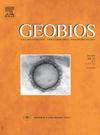基于红珊瑚的Nötsch地区(奥地利)密西西比中晚期的古生物地理意义
IF 1.6
4区 地球科学
Q2 PALEONTOLOGY
引用次数: 0
摘要
Nötsch(南奥地利)石炭纪由三个组组成:Erlachgraben组、Badstub角砾岩组和Nötsch组,这些组产生了丰富的珊瑚,其中一些是该地区的新珊瑚。该组合由11种红珊瑚组成(Siphonophyllia sp., Pseudozaphrentoides juddi, Lublinophyllum?2个表形种(multicoporora sp.和palaeaphyllia mirabilis)和1个异形种(hexaphylia mirabilis)。此外,我们收集的五种未被先前作者鉴定的rugosia (Clisiophyllum sp., Pseudozaphrentoides sp., Caninia sp.,“Palaeosmilia isae”和Lophophyllidium sp.)。书中描述了褶皱和表状的种类。利用Simpson和Dice相似指数进行了分层聚类分析,比较了Nötsch和其他奥地利露头与中欧其他地区的密西西比系组合。在属水平上对鹤纹珊瑚组合进行统计比较,可以更好地了解西古特提斯期Visean和Serpukhovian时期该部分浅水碳酸盐岩台地的分布。研究结果被纳入研究区晚维桑世古地理示意图。本文章由计算机程序翻译,如有差异,请以英文原文为准。
The palaeobiogeographic significance of the Nötsch area (Austria) during the Middle and Late Mississippian based on rugose corals
The Carboniferous of Nötsch (South Austria) is composed of three formations: the Erlachgraben Formation, the Badstub Breccia, and the Nötsch Formation, that yielded abundant corals, several of them being new for that region. The assemblage is composed of 11 rugose coral species (Siphonophyllia sp., Pseudozaphrentoides juddi, Lublinophyllum? sp., Dibunophyllum bipartitum, Arachnolasma cylindrica, Palaeosmilia murchisoni, Aulokoninckophyllum carinatum, Siphonodendron martini, Diphyphyllum furcatum, Solenodendron furcatum, and Solenodendron horsfieldi), two tabulate species (Multithecopora sp. and Palaeacis sp.) and one heterocoral species (Hexaphyllia mirabilis). In addition, five rugosans that are not in our collection have been identified by previous authors (Clisiophyllum sp., Pseudozaphrentoides sp., Caninia sp., “Palaeosmilia isae”, and Lophophyllidium sp.). The rugose and tabulate species are described and figured. A palaeobiogeographic analysis comparing the Mississippian assemblages from Nötsch and other Austrian outcrops with other domains in Central Europe has been performed using hierarchical clustering with Simpson and Dice similarity indices. The statistical comparison of the rugose coral assemblages at the genus level allows a better perception of the distribution of the shallow water carbonate platforms in that part of the Western Palaeotethys during the Visean and Serpukhovian. The results are incorporated in a schematic palaeogeographical map of the studied area for the late Visean.
求助全文
通过发布文献求助,成功后即可免费获取论文全文。
去求助
来源期刊

Geobios
地学-古生物学
CiteScore
3.30
自引率
6.20%
发文量
28
审稿时长
6-12 weeks
期刊介绍:
Geobios publishes bimonthly in English original peer-reviewed articles of international interest in any area of paleontology, paleobiology, paleoecology, paleobiogeography, (bio)stratigraphy and biogeochemistry. All taxonomic groups are treated, including microfossils, invertebrates, plants, vertebrates and ichnofossils.
Geobios welcomes descriptive papers based on original material (e.g. large Systematic Paleontology works), as well as more analytically and/or methodologically oriented papers, provided they offer strong and significant biochronological/biostratigraphical, paleobiogeographical, paleobiological and/or phylogenetic new insights and perspectices. A high priority level is given to synchronic and/or diachronic studies based on multi- or inter-disciplinary approaches mixing various fields of Earth and Life Sciences. Works based on extant data are also considered, provided they offer significant insights into geological-time studies.
 求助内容:
求助内容: 应助结果提醒方式:
应助结果提醒方式:


